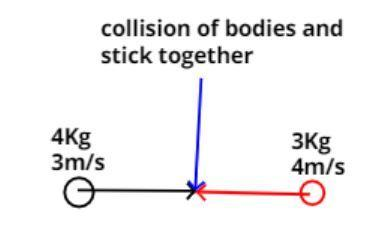
A body of mass 3Kg moving with a velocity of 4m/s towards the left collides head on with a body of mass 4kg moving in the opposite direction with a velocity of 3m/s. After collision the two bodies stick together and move with a common velocity which is:
$
(a){\text{ zero}} \\
{\text{(b) 12m/s towards left}} \\
{\text{(c) 12m/s towards right}} \\
{\text{(d) }}\dfrac{{12}}{7}{\text{m/s towards left}} \\
$
Answer
164.4k+ views
Hint: In this question let the velocity of the combined system after the collision be $v{\text{ m/s}}$. Apply the concept of conservation of momentum that is the momentum of the system before the system will be equal to the momentum of the system after the conservation. Momentum is given as a product of mass and velocity. This will help approaching the problem.
Complete step-by-step solution -

Given data:
Mass of first body is, ${m_1} = 3$Kg
Velocity of first body moving left as shown in the figure by red color is, ${u_1} = - 4$m/s, (‘-’ sign indicates the direction of the movement which is in negative direction of x-axis)
Mass of second body is, ${m_2} = 4$Kg
Velocity of second body moving opposite to first body as shown in the figure by black color is, ${u_2} = + 3$m/s, (‘+’ sign indicates the direction of the movement which is in positive direction of x-axis)
Now it is given that after the collision the two bodies are stick together and move with a common velocity,
Let the common velocity be V and the combined mass is $\left( {{m_1} + {m_2}} \right)$Kg.
Now according to conservation of linear momentum, as momentum is the product of mass and velocity.
The sum of individual momentum of the first and second body is equal to the sum of combined momentum i.e. after the collision when two bodies stick together.
Therefore,
$ \Rightarrow {m_1}{u_1} + {m_2}{u_2} = \left( {{m_1} + {m_2}} \right)V$
Now substitute the values we have,
$ \Rightarrow \left( 3 \right)\left( { - 4} \right) + \left( 4 \right)\left( 3 \right) = \left( {3 + 4} \right)V$
Now simplify this we have,
$ \Rightarrow 7V = - 12 + 12 = 0$
$ \Rightarrow V = 0$
So the combined velocity of the two bodies is zero.
So this is the required answer.
Hence option (A) is the correct answer.
Note – Since the bodies stick together after the collision therefore it implies that the collision was perfectly inelastic that is coefficient of restitution in this case will be 0. The coefficient of restitution is always in between 0 to 1, that is $0 < e < 1$.
Complete step-by-step solution -

Given data:
Mass of first body is, ${m_1} = 3$Kg
Velocity of first body moving left as shown in the figure by red color is, ${u_1} = - 4$m/s, (‘-’ sign indicates the direction of the movement which is in negative direction of x-axis)
Mass of second body is, ${m_2} = 4$Kg
Velocity of second body moving opposite to first body as shown in the figure by black color is, ${u_2} = + 3$m/s, (‘+’ sign indicates the direction of the movement which is in positive direction of x-axis)
Now it is given that after the collision the two bodies are stick together and move with a common velocity,
Let the common velocity be V and the combined mass is $\left( {{m_1} + {m_2}} \right)$Kg.
Now according to conservation of linear momentum, as momentum is the product of mass and velocity.
The sum of individual momentum of the first and second body is equal to the sum of combined momentum i.e. after the collision when two bodies stick together.
Therefore,
$ \Rightarrow {m_1}{u_1} + {m_2}{u_2} = \left( {{m_1} + {m_2}} \right)V$
Now substitute the values we have,
$ \Rightarrow \left( 3 \right)\left( { - 4} \right) + \left( 4 \right)\left( 3 \right) = \left( {3 + 4} \right)V$
Now simplify this we have,
$ \Rightarrow 7V = - 12 + 12 = 0$
$ \Rightarrow V = 0$
So the combined velocity of the two bodies is zero.
So this is the required answer.
Hence option (A) is the correct answer.
Note – Since the bodies stick together after the collision therefore it implies that the collision was perfectly inelastic that is coefficient of restitution in this case will be 0. The coefficient of restitution is always in between 0 to 1, that is $0 < e < 1$.
Recently Updated Pages
Uniform Acceleration - Definition, Equation, Examples, and FAQs

JEE Main 2021 July 25 Shift 1 Question Paper with Answer Key

JEE Main 2021 July 22 Shift 2 Question Paper with Answer Key

JEE Atomic Structure and Chemical Bonding important Concepts and Tips

JEE Amino Acids and Peptides Important Concepts and Tips for Exam Preparation

JEE Electricity and Magnetism Important Concepts and Tips for Exam Preparation

Trending doubts
JEE Main 2025 Session 2: Application Form (Out), Exam Dates (Released), Eligibility, & More

Atomic Structure - Electrons, Protons, Neutrons and Atomic Models

Displacement-Time Graph and Velocity-Time Graph for JEE

JEE Main 2025: Derivation of Equation of Trajectory in Physics

Learn About Angle Of Deviation In Prism: JEE Main Physics 2025

Electric Field Due to Uniformly Charged Ring for JEE Main 2025 - Formula and Derivation

Other Pages
JEE Advanced Marks vs Ranks 2025: Understanding Category-wise Qualifying Marks and Previous Year Cut-offs

NCERT Solutions for Class 11 Physics Chapter 1 Units and Measurements

Units and Measurements Class 11 Notes: CBSE Physics Chapter 1

NCERT Solutions for Class 11 Physics Chapter 2 Motion In A Straight Line

Motion in a Straight Line Class 11 Notes: CBSE Physics Chapter 2

Important Questions for CBSE Class 11 Physics Chapter 1 - Units and Measurement




